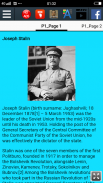








Biography of Stalin

Biography of Stalin का विवरण
Joseph Stalin (birth surname: Jughashvili; 18 December 1878[1] – 5 March 1953) was the leader of the Soviet Union from the mid-1920s until his death in 1953. Holding the post of the General Secretary of the Central Committee of the Communist Party of the Soviet Union, he was effectively the dictator of the state.
Stalin was one of the seven members of the first Politburo, founded in 1917 in order to manage the Bolshevik Revolution, alongside Lenin, Zinoviev, Kamenev, Trotsky, Sokolnikov and Bubnov.[2] Among the Bolshevik revolutionaries who took part in the Russian Revolution of 1917, Stalin was appointed General Secretary of the party's Central Committee in 1922. He subsequently managed to consolidate power following the 1924 death of Vladimir Lenin by suppressing Lenin's criticisms (in the postscript of his testament) and expanding the functions of his role, all the while eliminating any opposition. He remained general secretary until the post was abolished in 1952, concurrently serving as the Premier of the Soviet Union from 1941 onward.
Under Stalin's rule, the concept of "Socialism in One Country" became a central tenet of Soviet society, contrary to Leon Trotsky's view that socialism must be spread through continuous international revolutions. He replaced the New Economic Policy introduced by Lenin in the early 1920s with a highly centralised command economy, launching a period of industrialization and collectivization that resulted in the rapid transformation of the USSR from an agrarian society into an industrial power.[3] However, the economic changes coincided with the imprisonment of millions of people in Gulag labour camps.[4] The initial upheaval in agriculture disrupted food production and contributed to the catastrophic Soviet famine of 1932–33, known as the Holodomor in Ukraine. Between 1934 and 1939 he organized and led a massive purge (known as "Great Purge") of the party, government, armed forces and intelligentsia, in which millions of so-called "enemies of the working class" were imprisoned, exiled or executed, often without due process. Major figures in the Communist Party and government, and many Red Army high commanders, were killed after being convicted of treason in show trials.[5]
जोसेफ स्टालिन (जन्म उपनाम: Jughashvili, 18 दिसंबर 1878 [1] - 5 मार्च 1953) था की केंद्रीय समिति के महासचिव का पद धारण 1953 में अपनी मृत्यु तक मध्य 1920 के दशक से सोवियत संघ के नेता सोवियत संघ की कम्युनिस्ट पार्टी, वह प्रभावी रूप से राज्य के तानाशाह था।
स्टालिन, लेनिन, Zinoviev, Kamenev, ट्रोट्स्की, Sokolnikov और Bubnov साथ बोल्शेविक क्रांति का प्रबंधन करने के क्रम में 1917 में स्थापित पहला पोलित ब्यूरो के सात सदस्यों में से एक था। [2] रूसी क्रांति में हिस्सा लेने वाले बोल्शेविक क्रांतिकारियों के अलावा 1917 की, स्टालिन, सब के महासचिव बाद में उसने (अपने वसीयतनामा के उपसंहार में) लेनिन की आलोचनाओं को दबा है और उसकी भूमिका के कार्यों का विस्तार से व्लादिमीर लेनिन की 1924 मृत्यु के बाद सत्ता को मजबूत करने में कामयाब 1922 में पार्टी की केंद्रीय समिति के लिए नियुक्त किया गया जबकि किसी भी विपक्षी को नष्ट करने। पोस्ट समवर्ती आगे 1941 से सोवियत संघ के प्रीमियर के रूप में सेवारत, 1952 में समाप्त कर दिया गया था जब तक वह महासचिव बने रहे।
स्टालिन के नियम के तहत, "एक देश में समाजवाद की अवधारणा" समाजवाद सतत अंतरराष्ट्रीय क्रांतियों के माध्यम से फैल जाना चाहिए कि लियोन ट्रोट्स्की के विचार के विपरीत सोवियत समाज के एक केंद्रीय सिद्धांत बन गया है। उन्होंने कहा कि एक औद्योगिक शक्ति के रूप में एक कृषि प्रधान समाज से सोवियत संघ के तेजी से परिवर्तन के परिणामस्वरूप है कि औद्योगीकरण और सामूहीकरण की अवधि शुरू करने, एक अत्यधिक केंद्रीकृत आदेश अर्थव्यवस्था के साथ 1920 के दशक में लेनिन ने शुरू की नई आर्थिक नीति बदल दिया। [3] हालांकि, आर्थिक परिवर्तन। गुलाग श्रम शिविरों में लोगों के लाखों लोगों के कारावास के साथ हुई [4] कृषि के क्षेत्र में प्रारंभिक उथल-पुथल खाद्य उत्पादन बाधित और यूक्रेन में Holodomor के रूप में जाना जाता 1932-33 की भयावह सोवियत अकाल, करने के लिए योगदान दिया। 1934 और 1939 के बीच वह संगठित और ("महान पर्ज" के रूप में जाना जाता है) तथाकथित "श्रमिक वर्ग के दुश्मनों" के लाखों लोगों की कैद निर्वासित या मार डाला गया है जिसमें पार्टी, सरकार, सशस्त्र बलों और बुद्धिजीवियों के एक बड़े पैमाने पर शुद्ध नेतृत्व में , अक्सर कारण प्रक्रिया के बिना। कम्युनिस्ट पार्टी और सरकार, और कई लाल सेना के उच्च कमांडरों में मेजर आंकड़े, दिखाने के परीक्षण में राजद्रोह का दोषी ठहराए जाने के बाद मौत हो गई थी। [5]


























